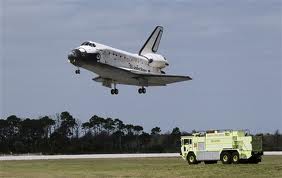
This article was last updated on April 16, 2022
Canada: ![]() Oye! Times readers Get FREE $30 to spend on Amazon, Walmart…
Oye! Times readers Get FREE $30 to spend on Amazon, Walmart…
USA: ![]() Oye! Times readers Get FREE $30 to spend on Amazon, Walmart…
Oye! Times readers Get FREE $30 to spend on Amazon, Walmart…
 The space shuttle Discovery landed today marking the end to the longest running shuttle in history. It was the third operational orbiter, starting its career in 1984. It ends 27 years later with total time in space of 365 days, a full year.
The space shuttle Discovery landed today marking the end to the longest running shuttle in history. It was the third operational orbiter, starting its career in 1984. It ends 27 years later with total time in space of 365 days, a full year.
Two other shuttles remain in service. Atlantis is scheduled to blast off on June 28, 2011 with Endeavour remaining as its backup.
Discovery has had an illustrious service record. It carried the Hubble Space Telescope into orbit in 1990 and subsequently undertook the missions to repair the telescope. It also launched the Ulysses probe in 1990 and the TDRS satellites. In 1998, the shuttle carried the Project Mercury astronaut John Glenn, who was 77 at the time, making him the oldest human being to go into space. Glenn flew in Mercury on February 20, 1962 completing 3 orbits of the Earth.
End of shuttles
This year marks the end of NASA’s shuttle program. At the moment, there are no new space craft in the wings and it is up in the air just what the American space program may do next. In the meantime, if the United States wants to go to the International Space Station, it will have to do so in a Russian rocket.
Discovery glides into history.
From the blue skies above Florida the shuttle Discovery glided down to a landing that closed a remarkable 27 year career in space. Discovery had carried the first female pilot, the first African American space walker and the oldest astronaut John Glenn. It was the first shuttle to go back into orbit following the Columbia and Challenger accidents.
Wikipedia: Space Shuttle Discovery
January 28, 1986
Just a short time ago, we celebrated – or maybe "marked the date" is a better expression – of the Challenger space shuttle disaster. 73 seconds after launch, the Space Shuttle Challenger disintegrated over the Atlantic Ocean killing the entire crew. I saw the event live on TV and those that didn’t, I’m sure have seen the footage many times over the years.
I wrote a blog posting about the event and the important back story to why the disaster happened in the first place. Yes, it was a tragedy but it was a tragedy compounded by a series of gross missteps on the part of management which remains a lesson for anyone involved in big business and project management.
Read my blog January 28, 1986, 11:38am: Oh, that’s what an O-ring is for!
Click HERE to read more from William Belle
Article viewed at: Oye! Times at www.oyetimes.com

Be the first to comment